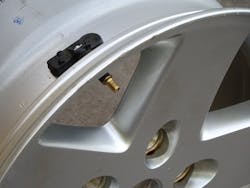University of Extrication: Vehicle Stabilization Techniques—Part 1
Subject: Vehicle Stabilization
Topic: Tire Deflation Challenges
Objective: Understand various tire-deflation techniques for use at crash scenes
Task: The rescue team shall demonstrate various methods to effectively deflate a vehicle tire when a tire-pressure monitoring system or new technology metal valve stems are present.
Tire Deflation Tactics
- Pull valve stem
- Cut valve stem
- Remove valve stem core
- Place a tire chuck on the valve stem
- Puncture or cut tire
One fundamental element of an effective vehicle rescue incident, especially when a patient is trapped in a crash-damaged vehicle, is that the vehicle is properly stabilized. When the vehicle is resting on its tires on a level surface, the stabilization task involves three elements: “chocking, blocking and blowing” the tires.
This training phrase is meant to emphasize the three components of simple vehicle stabilization. Chocking one wheel initially prevents the vehicle from rolling forward or backward. Blocking under the rockers takes the sway out of the vehicle and makes it a lot more stable. Step chocks are the most common means of blocking under the vehicle. Deflating the tires is the final step that allows the full weight of the vehicle to settle onto the cribbing placed under the rockers.
There are several methods by which fire/rescue personnel can deflate a tire once the chocks and blocks are in place. Pulling a valve stem, cutting a valve stem, placing a tire chuck on the valve stem, or removing the core out of the valve stem are just some of the tire-deflation techniques. If a crew doesn’t use any of these valve stem tire-deflation techniques, they typically use a sharp tool to puncture the rubber tire itself to release the air.
One popular feature found in many late-model vehicles is a tire-pressure monitoring system. Rescue personnel must be aware that the valve stems have large pressure sensor transmitters at their base end, which are mounted inside the wheel. With this design, it is not possible to pull the valve stem.
In addition to tire-pressure monitoring systems being present, rescuers may also encounter another new technology. The valve stems may look like the older standard valve stem design but may in fact be a rubber-coated metal core valve stem. The rubber-coated steel or aluminum metal core of the valve stem may be thicker and tough enough that the valve stem cannot be cut through with a pair of side cutters as is normally possible.
Next time
In Part 2 of this series, we will look at the challenge of deflating tires that are designed as either self-sealing or are one of several run-flat tire designs.
About the Author
Ron Moore
RON MOORE, who is a Firehouse contributing editor, recently retired as a division chief with the McKinney, TX, Fire Department and now serves with Prosper, TX, Fire Rescue. He self-published the Vehicle Rescue 1-2-3 training manual and serves as the forum moderator for the extrication section of Firehouse.com . Moore can be contacted directly at [email protected].

